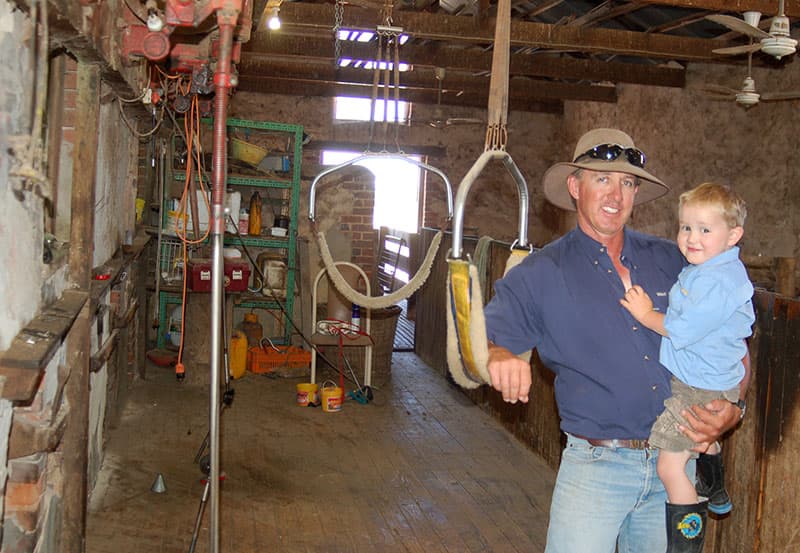Dohne advantage included in management changes
By Carla Wiese-Smith | 25th July 2013 | The Land

John McAnaney is pictured holding youngest son Ryan in the shearing shed on the West Slopes property. He sees a big future for Dohnes.
In the challenging environment of the Lower Lakes area of South Australia, John McAnaney and his family are well used to the need for production efficiencies on their 2,360 hectare property to keep their ‘head above water’.
Part of the changes they have instigated for enterprise efficiencies has been the introduction of Dohnes into their sheep program, which has proved to be a very successful move.
John and Tracy have three children; Chelsea, Mitchel and Ryan and run the property in conjunction with John’s parents Terry and Jan, and brothers Rob and Grant and their families. With four families reliant on the property for income, of which half is marginal lake edge country, suitable only for light sheep grazing, the pressure is on. While all family members help with all enterprises, which include a vineyard, cropping, cattle and sheep, it is John’s responsibility to oversee the sheep program of around 2,000 breeding ewes.
Historically their sheep enterprise was a self-replacing Merino flock, with the main income being from the wool produced.
“In 1994 we topped the wool market, but despite this, when we did our sums there just wasn’t enough money in the self replacing wool enterprise to continue as it was. It’s then that we decided to go into prime lamb production with terminal sire rams being put over bought in Merino ewes,” John said.
“We have targeted the domestic 20-22kg trade weight lamb market, which allows us to get top dollar in the shortest time period, rather than hang onto the lambs until heavy weights,” he added.
John explained that this has proven to be a profitable decision in the time since. However with the pressure on, the McAnaneys were always receptive to options that could further improve their bottom line.
To get better maternal traits with the thought of turning off their lambs even quicker led to them to try some Border Leicester/Merino cross ewes. However, they found there were issues in getting them to lamb ‘out of season’, so what they gained in maternal benefits was lost because of restrictive breeding.
Research convinced John to try a Dohne ram in late 2005. The first ram was mated to 60 ewes for an April lambing, then ‘recharged’ and mated with 140 ewes for an August lambing, successfully serving 200 ewes in the 1 year! They subsequently went back for more Dohne rams.
John sold the Dohne cross wether lambs at Dublin market in the middle of the traditional spring glut when prices are usually at their lowest. They received top end prices and also a ‘Pat on the Back’ in the Stock Journal.
Initially they kept the F1 and F2 ewe lambs, grew them out and mated them to the terminal sires as a test run. The benefits were that the lambs were able to be marketed at the target carcase weights three weeks earlier than off the straight Merino ewes; a significant advantage.
From John’s perspective, the Dohnes have a better frame and visual muscling conformation, plus they have far greater maternal efficiency. He hasn’t noticed any real difference in the wool cut.
“The better foraging ability of the Dohne cross ewes means they eat pasture Merinos won’t, so this probably offsets any potential genetic difference. Certainly the prices for the wool are no different,” John said.
“With better frames, good back ends and wide loins, plus superior mothering ability, a premium for these Dohne cross ewes has to come. As more producers see the economic advantages, it will no longer be an issue of personal choice, but rather one of economic reality,” John said.
“Being able to get better quality lambs off to market three weeks earlier and with no apparent downside in wool production or prices, is all the motivation we need to continue with our current course of action. I think it’s only a matter of time before a lot more producers come to realise this too,” he concluded.










 Facebook
Facebook YouTube
YouTube Instagram
Instagram